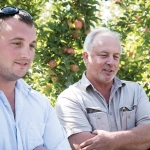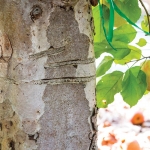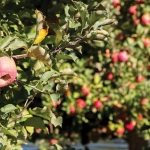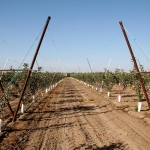
Steve Chinchiolo has found success growing conventional and organic apples and cherries in northern California. He’s looking to expand his organic apple production. Photo by TJ Mullinax/Good Fruit Grower
He planted a new apple orchard last spring, a testament to his upbeat outlook. The Gala block is trained to a V trellis, a system that provides better light distribution and is adaptable to labor-saving technology like platforms and harvest-assist machines. And once trees in the new orchard are well established, he plans to transition them to organic.
Chinchiolo began farming in his early 20s in 1977. Through the years, he’s grown almonds, peaches, nectarines, and also wine grapes that were field packed and shipped to Canadian and East Coast markets for home winemakers. But since the late 1980s, apples and cherries have been his main crops.
Chinchiolo is a name associated with cherries, and many are familiar with Chinchiolo Stemilt, the fresh cherry packing facility in Stockton, California, owned in part by Wenatchee, Washington-based Stemilt Growers, Inc. Steve Chinchiolo is related to Mike and Tom Chinchiolo of Chinchiolo Stemilt, but he is not presently involved with the cherry packing facility. However, he was involved with the facility years ago when it was an apple packing house called Sierra Hills.
Apples represent about 60 percent of his crop mix and cherries 40 percent. Though cherries have been a popular crop to plant in California in recent years, when Chinchiolo looks to the future, he’s looking to expand the apple side of his business.
Chinchiolo believes California apple growers have found their niche. They’ve learned what varieties do well and where, and the importance of market timing. “We’ve learned which varieties are the ones that we can be in and out of the market before Washington has a huge impact,” he said, adding that Gala has been a very successful variety.
“I haven’t planted a new cherry block in several years,” said Chinchiolo, adding that he’s concerned about the labor needed for cherries. “When I look around at the new cherry orchards in the area, not yet bearing, I see the need for 100 workers here, 100 workers there. Where are the workers going to come from? The combination of cherries and a labor shortage is like gasoline on fire.”
With apples, it’s not disaster if picking takes a few days longer because of a labor shortage, said the 57-year-old orchardist.
Chinchiolo’s main apple varieties are Gala, Granny Smith, Fuji (standard and early strains), and Cripps Pink (Pink Lady). Most of his Gala blocks are the Buckeye strain, a good-coloring strain for California that ripens around the end of July. His cherry varieties are Bing, Coral Champagne, and Utah Giant. He employs a core group of about ten local workers from February through November and uses two labor contractors to supply additional pickers for the cherry and apple harvest.
Chinchiolo said that having cherries and apples strengthens the commitment of his labor contractors to his operation because of the large number of workers needed. Thus far, he hasn’t experienced any labor shortages, but the worry is ever present.
Organic challenges
Chinchiolo grows both organic and conventional cherries and apples, marketing both crops through commercial packing houses as well as selling a small portion of his crop at farmers’ markets. He farms a total of around 280 acres of which about 110 acres (70 acres of cherries and 40 acres of apples) are organic. He’s been a certified organic grower since 2003.
“I’m under close scrutiny because I farm both conventionally and organically,” he said, noting that he must keep everything separate and well labeled. “But being both is a way for me to be diversified within the same crops I grow.”
His biggest challenge in organic cherries and apples is weed control. “The challenge is the strip under the tree row. In conventional farming, the strip is easily taken care of by strip spraying,” he said. “But there just aren’t any effective organic herbicides, and the ones that are registered are very expensive.”
He’s given son Alex the unenviable responsibility of weed control. In early spring, Alex uses a propane burner to singe small weeds.
“That works for a couple of times, but then the weeds get bigger and we have to switch to using a Lilliston-style cultivator called the Wonder Weeder,” said Alex Chinchiolo, who holds a degree in fruit science from California Polytechnic State University, San Luis Obispo. “In the middle of the growing season, we run the Wonder Weeder every 10 to 14 days, and in between, we have crews dedicated to cleaning the row strip with weed whackers.”
Chinchiolo likens their weed control program to painting the Golden Gate Bridge in San Francisco. “You finish on one end, and then it’s time to start again at the other end.”
A problem in one block of their organic cherries is black cherry aphid. “If it was a conventional block, it would be real easy to clean up,” he said. “But between the ants and the aphids, it’s tough.”
Alternate bearing
In the organic apples, the biggest problem is keeping the apples bearing annually. Chinchiolo has used both lime sulfur and oil to discourage biennial bearing, and found that lime sulfur alone works better in his orchards.
Of late, he’s turned to postbloom girdling to keep apple production on track. About ten days after bloom, he scores or girdles the trunk near the ground, a technique that also can be used in conventional blocks to control vigor.
“It’s a pretty powerful tool, but the downside is that you have to do it every year. In a sense, you get addicted to it, and if you miss a year, you can miss a crop,” Chinchiolo said. “You have to wean yourself off slowly by switching to a narrower girdle knife and then only girdling the bigger trunks in the block.”
Chinchiolo uses the girdling technique primarily in his organic Gala and Fuji blocks. Gala works well for his organic production because the variety is early and he doesn’t have to carry the crop as long as other varieties like Cripps Pink. Gala is also more tolerant of fireblight than Cripps Pink.
He has a small block of Honeycrisp and GoldRush apple trees that have potential for the organic market. “If the organic market stays as good as it has the last few years, I hope to transition more to organic, though I’d have to buy a few more weed whackers.”
Alex Chinchiolo, who’s taking an active role in the operation, explained that for their organic production, they want to get the orchard up and running before they transition to organic. “We want to develop good roots and a good foundation before we go organic,” he said. •










Leave A Comment